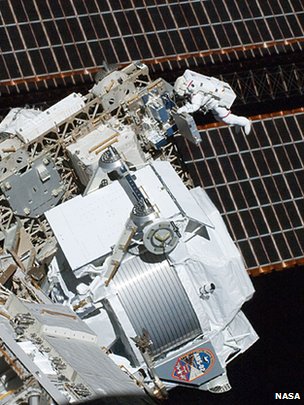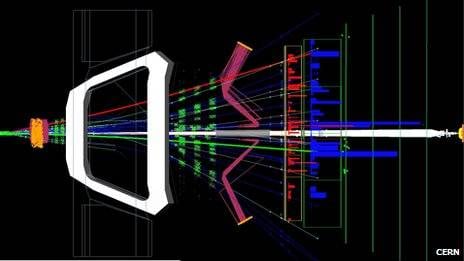&
Navigation
Install the app
How to install the app on iOS
Follow along with the video below to see how to install our site as a web app on your home screen.

Note: This feature currently requires accessing the site using the built-in Safari browser.
More options
You are using an out of date browser. It may not display this or other websites correctly.
You should upgrade or use an alternative browser.
You should upgrade or use an alternative browser.
Granny still don't understand how dey gonna see it if it's dark?

Alpha Magnetic Spectrometer zeroes in on dark matter
3 April 2013 - A $2bn experiment on the space station has made observations that could prove to be the first signs of dark matter, a mysterious component of the Universe.
See also:
Scientists find hint of dark matter from cosmos
Apr 3,`13 -- A $2 billion cosmic ray detector on the International Space Station has found the footprint of something that could be dark matter, the mysterious substance that is believed to hold the cosmos together but has never been directly observed, scientists say.

Alpha Magnetic Spectrometer zeroes in on dark matter
3 April 2013 - A $2bn experiment on the space station has made observations that could prove to be the first signs of dark matter, a mysterious component of the Universe.
The Alpha Magnetic Spectrometer (AMS) surveys the sky for high-energy particles, or cosmic rays. It has seen evidence of what may prove to be dark matter colliding with itself in what is known as "annihilation". But scientists stress a precise description of this mysterious cosmic component is still some way off. "It could take a few more years," AMS deputy spokesman Roberto Battiston, a professor of physics at the University of Perugia, told BBC News. Dark matter accounts for most of the mass in the Universe. It cannot be seen directly with telescopes, but astronomers know it to be out there because of the gravitational effects it has on the matter we can see. Galaxies, for example, could not rotate the way they do and hold their shape without the presence of dark matter.
The AMS - a particle physics machine nicknamed the "Space LHC" in reference to the Large Hadron Collider here on Earth - has been hunting for some indirect measures of dark matter's properties. It counts the numbers of electrons and their anti-matter counterparts - known as positrons - falling on an array of detectors. Theory suggests that showers of these particles should be produced when dark-matter particles collide somewhere in space and destroy each other. In a paper in the journal Physical Review Letters, the AMS team reports the observation of a slight excess of positrons in the positron-electron count - an outcome expected of these dark matter annihilations.

The AMS was taken up to the ISS in 2011
The group also says the positrons fall on the AMS from all directions in the sky with no particular variation over time. This is important because specific locations or timing variations in the signal could indicate a more conventional source for the particles, such as a pulsar (a type of neutron star) rather than dark matter. The AMS was placed on the International Space Station in 2011. The longer it operates, the better its statistics will be and the more definitive scientists can be in their statements. But lead spokesman, Prof Sam Ting, said the AMS Collaboration would proceed slowly. "It took us 18 years to do this experiment and we want to do it very carefully," he told a seminar at the European Laboratory for Particle Physics (Cern) in Geneva. "We will publish things when we are absolutely sure."
The Physical Review Letters paper reports the positron-electron count in the energy range of 0.5 to 350 gigaelectronvolts (GeV). The behaviour of the positron excess across this energy spectrum fits with the researchers' expectations. However, the "smoking gun" signature would be to see a rise in this ratio and then a dramatic fall. This has yet to be observed. "At the moment, all we can say is that the (dark matter) particles could have a mass of several hundred gigaelectronvolts, but there is much uncertainty," said Prof Battiston. (By way of comparison, a proton, the particle in the nucleus of every atom, has a mass of about 1 GeV).
Modern mysteries
See also:
Scientists find hint of dark matter from cosmos
Apr 3,`13 -- A $2 billion cosmic ray detector on the International Space Station has found the footprint of something that could be dark matter, the mysterious substance that is believed to hold the cosmos together but has never been directly observed, scientists say.
But the first results from the Alpha Magnetic Spectrometer, known by its acronym AMS, are almost as enigmatic as dark matter itself. They show evidence of new physics phenomena that could be the strange and unknown dark matter or could be energy that originates from pulsars, scientists at the European particle physics laboratory near Geneva announced Wednesday. The results from the detector are significant, because dark matter is thought to make up about a quarter of all the matter in the universe. Unraveling the mystery of dark matter could help scientists better understand the composition of our universe and, more particularly, what holds galaxies together. Nobel-winning physicist Samuel Ting, who leads the team, told colleagues at the European Organization for Nuclear Research, known as CERN, that he expects a more conclusive answer within months about this "unexpected new phenomena."
The 7-ton detector, which was sent into space two years ago and has a 3-foot (0.91-meter) magnet ring at its core, is transmitting the data to CERN on the Swiss-French border, where it is being analyzed. The instrument will search for antimatter and dark matter for the rest of the life of the space station - at least until 2020 - transmitting data to an international team of 600 scientists based in Geneva that is led by Ting, a physicist at the Massachusetts Institute of Technology. The findings Wednesday are based on seeing an excess of positrons - positively charged subatomic particles.
Since the highly accurate AMS magnetic detector began studying cosmic ray particles in space, it has found about 400,000 positrons whose surging energies indicate they might have been created when particles of dark matter collided and destroyed each other. "It is this level of precision that will allow us to tell whether our current positron observation has a dark matter or pulsar origin," Ting said. Other scientists praised the results and looked forward to more. "This is an 80-year-old detective story and we are getting close to the end," said University of Chicago physicist Michael Turner, one of the giants in the field of dark matter. "This is a tantalizing clue and further results from AMS could finish the story."
Source
Last edited:
Granny says it don't matter to her...

Antimatter results emerge at LHC - but puzzle abides
24 April 2013 - The quest to understand why our Universe is made of matter rather than antimatter has received a boost at the Large Hadron Collider.

Antimatter results emerge at LHC - but puzzle abides
24 April 2013 - The quest to understand why our Universe is made of matter rather than antimatter has received a boost at the Large Hadron Collider.
The LHCb experiment has for the first time observed decays of particles known as Bs mesons that preferentially end up as matter, rather than antimatter. However, the difference is still not enough to explain the preponderance of matter over antimatter in the cosmos. The work, published online, has been submitted to Physical Review Letters. Every member of the zoo of particles we know about has an antimatter cousin, identical in every way except for an opposite electric charge - the electrons and protons that in part make us up have positrons and antiprotons as their antimatter matches.

Collided protons turn into, for example, Bs mesons, pions and kaons
The current theory for how the Universe got its start holds that equal amounts of matter and antimatter were initially created. But whenever the two meet, they destroy each other in a flash of light. Simply put, the Universe should have come to a blazing end just then. Something must have made for a slight excess of matter in order to lead to the matter-dominated Universe we see today. It is the subtle details of this preference for matter that the LHCb experiment is hunting for as it tracks particles created when protons are smashed together. Just like the long-running hint for the particle called the Higgs boson, clues arise in the showers of particles created by these violent collisions.
'Puzzle continues'
Previous work at the LHCb had seen hints of an excess of matter - called CP violation - in combinations of the fundamental particles called quarks. At other experiments around the world, the family of particles called mesons had been tackled, and small amounts of CP violation had been seen in two of the four meson types that have no electric charge. A third type, D0 mesons, showed early hints of CP violation at LHCb in 2011, but more recent studies suggest those hints were mistaken.
The new work considered the fourth: Bs mesons. The LHCb team tracked how these particles decayed further into either the matter or antimatter version of particles called kaons. "If one decays more often to this final state... than the other one, then it shows a fundamental difference between matter and antimatter," said Chris Parkes of the University of Manchester, spokesperson for the UK contingent of the LHCb collaboration. "That's what we've seen - a difference of about one in four of these decays," he told the BBC. But that difference still neatly fits within existing theory - the Standard Model - leaving a mystery unresolved.
More BBC News - Antimatter results emerge at LHC - but puzzle abides
Similar threads
- Replies
- 63
- Views
- 1K
- Replies
- 154
- Views
- 7K
- Replies
- 32
- Views
- 2K
- Replies
- 143
- Views
- 2K
Latest Discussions
- Replies
- 106
- Views
- 825
- Replies
- 50
- Views
- 224
- Replies
- 3
- Views
- 9
Forum List
-
-
-
-
-
Political Satire 8029
-
-
-
-
-
-
-
-
-
-
-
-
-
-
-
-
-
-
-
ObamaCare 781
-
-
-
-
-
-
-
-
-
-
-
Member Usernotes 468
-
-
-
-
-
-
-
-
-
-
